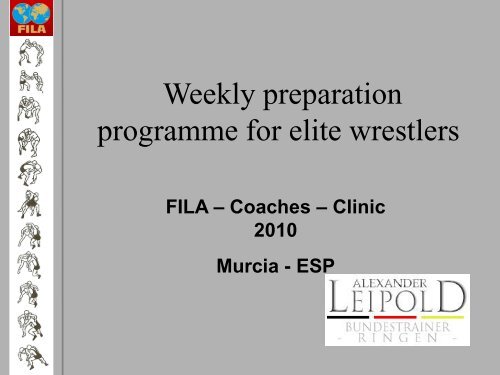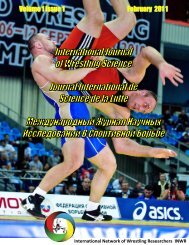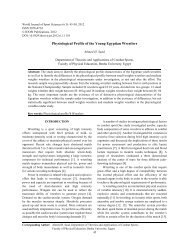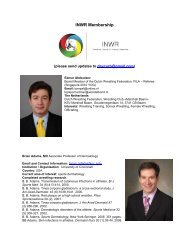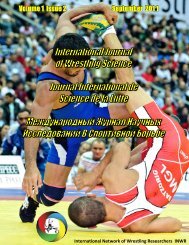Annual plan - INWR Wrestling
Annual plan - INWR Wrestling
Annual plan - INWR Wrestling
You also want an ePaper? Increase the reach of your titles
YUMPU automatically turns print PDFs into web optimized ePapers that Google loves.
Weekly preparation<br />
programme for elite wrestlers<br />
FILA – Coaches – Clinic<br />
2010<br />
Murcia - ESP<br />
Alexander Leipold<br />
Bundestrainer Deutschland<br />
Head Coach Germany
Why do you have to <strong>plan</strong><br />
the training?
We like to make a Champion
Planning of the training<br />
• Only if there is a perfect <strong>plan</strong>ning of the training the<br />
wrestler can effect optimal performance at the main<br />
competition<br />
• The whole <strong>plan</strong>ning focuses on the goal:<br />
„Optimal performance during European<br />
Championships and World Championships,<br />
as well as afterwards at the Olympic Games“<br />
• Planning includes:<br />
• The training session<br />
• The microcycle – <strong>plan</strong>ning for one week<br />
• The mesocycle – <strong>plan</strong>ing for several weeks<br />
• The macrocycle – <strong>plan</strong>ning for several months
Weekly preparation<br />
programme for elite wrestlers<br />
The weekly preparation<br />
is scientifically termed<br />
microcycle.
Weekly programme (Microcycle)<br />
Definition:<br />
Rather small training section consisting of<br />
several training units whose content and<br />
basic structure of dynamic loading, and<br />
therefore whose main effects, are repeated<br />
during the course of the training. The<br />
intensity is modified according to the<br />
development of the athlete's fitness<br />
condition.
The weekly preparation programme<br />
Is a short period during an Olympic cycle and<br />
ranges as follows:<br />
• Multi-annual <strong>plan</strong> (Olympic cycle)<br />
• <strong>Annual</strong> <strong>plan</strong> (competition year)<br />
• Mesocycle (several weeks)<br />
• Microcycle (weekly training <strong>plan</strong>)<br />
• Training unit
• Multi-annual <strong>plan</strong> (Olympic cycle)<br />
• <strong>Annual</strong> <strong>plan</strong> (competition year)<br />
• Mesocycle<br />
• Microcycle (weekly training programme)<br />
• Training unit<br />
Definition:<br />
The multi-annual <strong>plan</strong> covers for the most part an<br />
Olympic cycle and comprises a basic structure for<br />
training, which is concentrated for a goal over several<br />
years. In the case of an Olympic cycle the <strong>plan</strong>ning<br />
spans a four year period and finishes with the Olympic<br />
Games as the main competition.
• Multi-annual <strong>plan</strong> (Olympic cycle)<br />
• <strong>Annual</strong> <strong>plan</strong> (competition year)<br />
• Mesocycle<br />
• Microcycle (weekly training programme)<br />
• Training unit<br />
Definition:<br />
The goal of the annual <strong>plan</strong> is to reach top performance<br />
and to develop athletic form.<br />
In wrestling this is carried out in two cycles (macro cycle).<br />
In the annual <strong>plan</strong> the wrestlers prepare for the two<br />
competitive highlights, the European Championships and<br />
the World Championships.
• Multi-annual <strong>plan</strong> (Olympic cycle)<br />
• <strong>Annual</strong> <strong>plan</strong> (competition year)<br />
• Mesocycle<br />
• Microcycle (weekly training programme)<br />
• Training unit<br />
The training (macro) cycle can be repeated once or twice<br />
during the year, depending on the athletes ability. In<br />
wrestling it is repeated twice in the majority of cases.<br />
The (macro) cycle has 3 Periods:<br />
a) The Preparation Period<br />
b) The Competition Period<br />
c) The Transition Period<br />
The intensity of the phases reached a steadily increasing<br />
level during the training years and ultimately lead to the best<br />
performance of the wrestler.
• Multi-annual <strong>plan</strong> (Olympic cycle)<br />
• <strong>Annual</strong> <strong>plan</strong><br />
• Mesocycle<br />
• Microcycle (weekly training programme)<br />
• Training unit<br />
PREPARATION PERIODS Phases 1 + 2:<br />
Objective: development of athletic form<br />
The Preperation Periods has two phases:<br />
Phase 1: In the first phase overall conditioning training is at<br />
the fore.<br />
Phase 2: The second phase focuses on specific methods<br />
while reducing the scope of training and increasing the<br />
intensity.
• Multi-annual <strong>plan</strong> (Olympic cycle)<br />
• <strong>Annual</strong> <strong>plan</strong><br />
• Mesocycle<br />
• Microcycle (weekly training programme)<br />
• Training unit<br />
COMPETITION PERIOD:<br />
Objective: further development of athletic form<br />
The pressure of the different competitions facilitates the<br />
development and stabilisation of the individual athlete's top<br />
form. The quantity and quality of competitions entered is<br />
dependant upon the individual's capacity for handling the<br />
pressure.
• Multi-annual <strong>plan</strong> (Olympic cycle)<br />
• <strong>Annual</strong> <strong>plan</strong><br />
• Mesocycle<br />
• Microcycle (weekly training programme)<br />
• Training unit<br />
TRANSITION PERIOD:<br />
Objective: active recuperation and regeneration of the athlete<br />
In this phase of loss of form, the intensity and scope of the<br />
training is reduced. "Active recuperation" is achieved by<br />
participating in complementary sports, which prevent<br />
performance parameters from declining too sharply: in this<br />
way wrestlers will be able to keep their fitness at the agreed<br />
level by playing team sports (soccer etc.), and swimming,<br />
fitness etc. and recuperate as necessary at the same time.
• Multi-annual <strong>plan</strong> (Olympic cycle)<br />
• <strong>Annual</strong> <strong>plan</strong> (competition year)<br />
• Mesocycle<br />
• Microcycle (weekly training programme)<br />
• Training unit<br />
Definition:<br />
A rather medium-term training section (approx. 3-6<br />
weeks) consisting of several microcyles whose content<br />
and basic structure of dynamic loading, and therefore<br />
whose main effects, are repeated during the course of<br />
the training, and whose intensity is modified according<br />
to the development of the athlete's fitness condition.
• Multi-annual <strong>plan</strong> (Olympic cycle)<br />
• <strong>Annual</strong> <strong>plan</strong> (competition year)<br />
• Mesocycle<br />
• Microcycle (weekly training<br />
programme)<br />
• Training Unit<br />
The weekly training programme:<br />
The repetition of a weekly training <strong>plan</strong> can take place<br />
directly or be alternated with another weekly training<br />
<strong>plan</strong>.<br />
The weekly training <strong>plan</strong> follows the calendar week for<br />
the most part, as this allows an easy <strong>plan</strong>ning
Weekly training programme<br />
The role of a weekly training programme<br />
is to ensure an optimal proportion of<br />
exertion to recuperation.<br />
The weekly <strong>plan</strong> should combine the<br />
effects of the individual training units and<br />
its overall effect should be to steer the<br />
training in the predetermined direction of<br />
the higher level mesocycle.
Intensity
Example<br />
Weekly Preparation Programm<br />
during the<br />
Preparation Period
Example 1
Example 2
Example 3
The <strong>plan</strong> for the training session<br />
• Includes practical information for the<br />
structuring of each training session<br />
• Describes the aspired load, as well as<br />
methods, contents, and means<br />
• Provides information about<br />
– The warm-up programme<br />
– The focus of the training session<br />
– The end of the training
Structure of a training unit<br />
• Preparational part<br />
• Main part<br />
• Closing part<br />
• Follow-Up
Preparational Part<br />
„ Preparation is the optimal adjustment of<br />
the athlete to the requirements of the<br />
training session by means of<br />
psychological and educational regulation<br />
of behaviour with help of the physical<br />
preparation. A positive and confident<br />
position towards the exercise will<br />
upgrade the training effect.“
• Creating optimal readiness for the training<br />
• Providing optimal muscle elasticity by<br />
loosening and stretching exercises<br />
• Implementation of specific movements, reach<br />
optimal ability to respond<br />
• Duration: about 15 – 30 minutes<br />
• From general to specific physical preparation<br />
• General physical preparation:<br />
– Simple, familiar exercises<br />
– Easy running exercises<br />
– Loosening and stretching exercises<br />
(gymnastics)<br />
– Ball games<br />
• Specific physical preparation:<br />
– Preparation for the main part of the training<br />
by increasingly specific exercises
Main Part<br />
• Exercises that focus on consolidation and<br />
edvancement of the athletic performance<br />
• Individual exercises, mainly for technicaltactical<br />
education and for endurance<br />
oriented education<br />
• Consideration of the correct order of load<br />
when educating several exercices during<br />
one training unit<br />
• Duration: about 45 – 60 Minutes
Closing Part<br />
• Gradual load reducion with exercises relaxing and<br />
stretching the muscles, releasing the neural stress<br />
by decreasing concentration<br />
• Aktive readjustment of cardiovascular system and<br />
metabolism to pre-load values (e.g. running down)<br />
• Emphasis on fun at the end of the training session<br />
for a positive attitude towards the next training<br />
session
Follow-up<br />
• Follow-Up:<br />
– Analysis of the training session regarding its<br />
effectivity<br />
• Training documentation<br />
�Follow-up is important for an optimal<br />
management and control of the training –<br />
process
Thank you very much for<br />
your attention
Questions?


